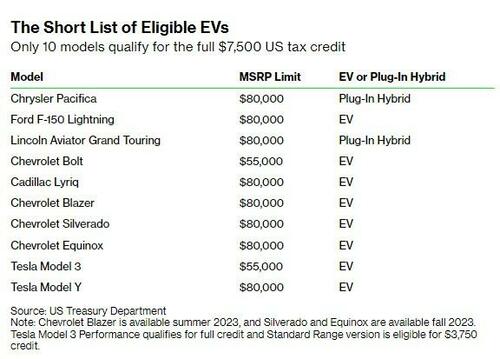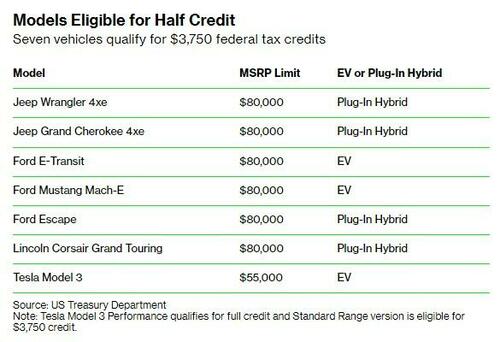
So much for the "we're not trying to pick winners or losers in the EV market" thesis from the Biden administration.
The new $7,500 tax credit that comes as part and parcel with the Inflation Reduction Act (we'll pause for the irony of subsidies included in a bill aimed at curbing inflation) only includes 10 electric and plug-in hybrid vehicles, according to new reporting from Bloomberg.
The companies that will have at least one vehicle that qualifies includes Tesla, GM, Ford and Stellantis. The credits kick in on Tuesday and strict battery-sourcing rules make most other vehicles ineligible.
The act mandates that battery components or raw materials must be sourced from the U.S. or from countries that the U.S. has free-trade agreements with. Here's Bloomberg's full list of vehicles that qualify:
The guidelines cut in half the number of eligible vehicles from those that qualified earlier this year when the Treasury was still working up the criteria, the report says. Companies like Volkswagen, Hyundai and Nissan all had vehicles that were once eligible for partial credits that are no longer eligible for any credits, according to the U.S. Department of Energy.
7 vehicles qualify for a half credit of $3,750, including vehicles made by Tesla, Ford and Stellantis:
Three vehicles eligible for the full credit won't even be available until this summer or fall, Bloomberg writes, adding that VW is waiting for documentation to see if its ID.4 SUV will also qualify.
As the article concludes, the shortlist of qualified vehicles is supposed to be a positive:
The stringency of the sourcing rules within the IRA are a feature, not a bug. West Virginia Senator Joe Manchin initially balked at the Biden administration’s efforts to expand the availability of EV credits, citing long waiting lists that reflected manufacturers’ inability to keep up with demand. He came around only on the condition that incentives go to companies producing EVs in North America with localized supply chains. Credits also are restricted to vehicles under certain price thresholds and limited to taxpayers below income caps.
As we wrote days ago, the auto industry has become a case of Joe Biden versus the free market. Last Friday we wrote about how, despite enormous subsidies, EV adoption in the United States was slowing. In other words, it turns out, not everybody shares the virtue signaling stance of blindly switching to a more expensive method of driving with more complex refueling demands...just because the government "said so".
But then the Biden administration unveiled what Fox News is calling "the most aggressive tailpipe emissions ever crafted" to try and further a push into EVs.
The new rules proposed by the EPA and White House "will impact car model years 2027 through 2032". The White House claims they will result in "carbon emission reductions of nearly 10 billion tons by 2055 and would save consumers an average of $12,000 over the lifetime of vehicles," the report says.
Meanwhile, critics state the obvious: that new rules on emission standards (and battery sourcing) will make the cost of all vehicles rise - specifically while the nation is supposedly trying to fight inflation and look out for the middle and lower class.
So much for the “we’re not trying to pick winners or losers in the EV market” thesis from the Biden administration.
The new $7,500 tax credit that comes as part and parcel with the Inflation Reduction Act (we’ll pause for the irony of subsidies included in a bill aimed at curbing inflation) only includes 10 electric and plug-in hybrid vehicles, according to new reporting from Bloomberg.
The companies that will have at least one vehicle that qualifies includes Tesla, GM, Ford and Stellantis. The credits kick in on Tuesday and strict battery-sourcing rules make most other vehicles ineligible.
The act mandates that battery components or raw materials must be sourced from the U.S. or from countries that the U.S. has free-trade agreements with. Here’s Bloomberg’s full list of vehicles that qualify:
The guidelines cut in half the number of eligible vehicles from those that qualified earlier this year when the Treasury was still working up the criteria, the report says. Companies like Volkswagen, Hyundai and Nissan all had vehicles that were once eligible for partial credits that are no longer eligible for any credits, according to the U.S. Department of Energy.
7 vehicles qualify for a half credit of $3,750, including vehicles made by Tesla, Ford and Stellantis:
Three vehicles eligible for the full credit won’t even be available until this summer or fall, Bloomberg writes, adding that VW is waiting for documentation to see if its ID.4 SUV will also qualify.
As the article concludes, the shortlist of qualified vehicles is supposed to be a positive:
The stringency of the sourcing rules within the IRA are a feature, not a bug. West Virginia Senator Joe Manchin initially balked at the Biden administration’s efforts to expand the availability of EV credits, citing long waiting lists that reflected manufacturers’ inability to keep up with demand. He came around only on the condition that incentives go to companies producing EVs in North America with localized supply chains. Credits also are restricted to vehicles under certain price thresholds and limited to taxpayers below income caps.
As we wrote days ago, the auto industry has become a case of Joe Biden versus the free market. Last Friday we wrote about how, despite enormous subsidies, EV adoption in the United States was slowing. In other words, it turns out, not everybody shares the virtue signaling stance of blindly switching to a more expensive method of driving with more complex refueling demands…just because the government “said so”.
But then the Biden administration unveiled what Fox News is calling “the most aggressive tailpipe emissions ever crafted” to try and further a push into EVs.
The new rules proposed by the EPA and White House “will impact car model years 2027 through 2032”. The White House claims they will result in “carbon emission reductions of nearly 10 billion tons by 2055 and would save consumers an average of $12,000 over the lifetime of vehicles,” the report says.
Meanwhile, critics state the obvious: that new rules on emission standards (and battery sourcing) will make the cost of all vehicles rise – specifically while the nation is supposedly trying to fight inflation and look out for the middle and lower class.
Loading…






